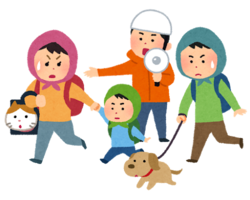Evacuating with Pets in an Emergency
Natural disasters and emergency situations happen suddenly and without warning, which means that pet owners are the only ones who can ensure the safety of their pets. What’s important is that you as a pet owner are safe, and in the event that you have to evacuate, you can do so safely with your pets.
As a general rule, it is your responsibility as a pet owner to care for, feed, and manage your pet and the space they are in while at an evacuation site.
Stay prepared so that you can evacuate with your pet safely and spend time comfortably at the place where you evacuate, without inconveniencing those around you.
The Importance of Evacuating With Pets
In past natural disasters and emergencies, there were many cases of pets being separated from their owners. Not only does it require a lot of manpower and time to find and rescue these pets, there is also the chance that these pets could become injured, weakened, or even die while waiting to be rescued.

There are also concerns that pets that have not been spayed or neutered will reproduce, causing the number of strays to rise, which becomes a public safety and public sanitation issue.
Evacuating with your pet essential in preventing these concerns, not only from an animal protection standpoint, but also from the standpoints of preventing strays from attacking people, as well as conserving a hygienic environment.
Please note that evacuating with your pet refers to the act of evacuating only; it does not mean taking care of pets in the same space as people in designated emergency evacuation sites.
Taking Pets to Evacuation Sites
In principle, you can bring pets with you to any evacuation site, but it is very important that there are separate spaces for people and pets.
Why people and pets need to be kept separate
- It is considerate to people who are uncomfortable around animals or who have allergies.
- It reduces or mitigates incidents that arise from people and animals living in the same place.
Spaces provided for pets
- At evacuation sites, pets are to be kept not indoors, but in covered outdoor spaces. Owners are expected to bring their own carry cases or crates and keep their pets in these.
- It is the responsiblity of owners to clean up after their pets, feed them, and otherwise care for them.
For details on spaces provided at specific sites, please contact your local ward office's Community Revitalization Division.
|
Division |
Phone |
|
|---|---|---|
| Community Revitalization Division Naka Ward Office |
082-504-2820 | [email protected] |
| Community Revitalization Division Higashi Ward Office |
082-568-7705 | [email protected] |
| Community Revitalization Division Minami Ward Office |
082-250-8935 | [email protected] |
| Community Revitalization Division Nishi Ward Office |
082-532-0927 | [email protected] |
| Community Revitalization Division Asaminami Ward Office |
082-831-4926 | [email protected] |
| Community Revitalization Division Asakita Ward Office |
082-819-3905 | [email protected] |
| Community Revitalization Division Aki Ward Office |
082-821-4905 | [email protected] |
| Community Revitalization Division Saeki Ward Office |
082-943-9704 | [email protected] |
Pets allowed at evacuation shelters
As a general rule, pets that are allowed in evacuation shelters are pets that have evacuated with their owners from their homes, such as dogs, cats, and other small animals (hamsters, rabbits, birds, etc).
For-sale animals that are property of pet shops/dealers and animals which are thought to be dangerous to people or other pets will not be allowed in evacuation sites.
Note: seeing eye dogs, service dogs, and hearing assistance dogs (referred to collectively as "assistance dogs" below) as stipulated by the Act on Assistance Dogs for Physically Disabled Persons will be allowed in the same space as physically disabled evacuees who need them.
Pet Training and Health Management
To avoid problems while in an evacuation site, be sure to keep your pets trained and healthy. Following the proper etiquette when taking care of your pet so that they do not cause problems for your neighbors is key to having them accepted at evacuation sites and spending time there safely and without worry.
Be sure to teach your pet not to bark excessively, get your pet used to being in pet carry cases or crates, and train them to interact with people in a friendly manner. Be mindful of their health and keep them clean; be sure they’re vaccinated and free of external parasites such as fleas.
Pet numbers and other considerations
- Consider the number of pets you can bring with you
The number of pets that can evacuate with you is limited; be sure you consider this and keep only the number of pets you can safely evacuate with.
For families who already have multiple pets: if it seems difficult for you to evacuate with all of your pets, it is vitally important that you ask for help from your local community or pet community. - Keep cats indoors
When cats are kept outdoors, they cannot be called home during an emergency, which means you cannot evacuate with them. Keeping cats indoors not only helps to protect the health and safety of your cats, but it’s also an important way to stay prepared for emergencies.

Pet IDs
- You may get separated from your pets during emergency situations which happen suddenly.
Be sure to keep a collar or something to identify your pet on them so that if they are rescued in an emergency, they can be returned to you. - Dog owners are required by law to keep license tags and rabies vaccination certificates on their dogs at all times under the Rabies Prevention Law.

Evacuation Provisions and Essential Stocks for Pets
Make sure you keep a stock of essentials for your pets to stay prepared for the event of losses of critical infrastructures and emergency evacuations.

Evacuation sites are prepared for human evacuees; provisions and essentials for your pet are your responsibility as a pet owner.
It may take time for relief aid to reach your evacuation site, so be sure you have at least five days worth of provisions.
Checklist: Do you have these ready for an emergency?
- Medicine
- Enough pet food and water for five days
- Carry case
- Collar and lead (non-extendable)
- Pet Health Record Book (if you have one)
- Pee pads
- Supplies for cleaning up after pets
- Litter box, litter that cats are used to, etc.
- Bowls and other feeding supplies
- Laundry net (for cats)
Be sure you have options
Natural disasters and emergencies are a huge source of stress for pets.
To help cope with that stress, be sure to consult with relatives, friends, pet hotels, or vet clinics beforehand about taking in your pets for a little while in the event of an emergency so that you have options if you need them.
Useful Pages for Disaster Preparation
-
Protect Your Pets! Disaster Preparation Measures(External link)

(Japanese, Ministry of the Environment Website) -
We Want to Stay Together(External link)

(Japanese, Ministry of the Environment Website) -
Are You and Your Pets Safe in Case of Disaster? Disaster Preparedness Guideline for Humans and Pets (For General Pet Owners)(External link)

(Ministry of the Environment Website) -
避難場所
List of Emergency Evacuation Shelters in Hiroshima City
Inquiries
About caring for pets
Animal Care Center, Health Department, Health and Welfare Bureau
Tel: 082-243-6058 / Fax: 082-243-6276
Mail: [email protected]
About places to evacuate to
Disaster Prevention Division, Crisis Management Office
Tel: 082-504-2664 / Fax: 082-504-2802
Mail: [email protected]
About this page
Animal Care Center, Health Department, Health and Welfare Bureau
11-27 Fujimi-cho, Naka-ku, Hiroshima
Tel: 082-243-6058 / Fax: 082-243-6276
Mail: [email protected]
